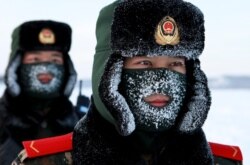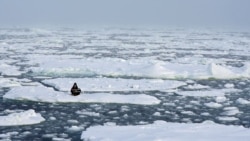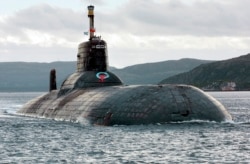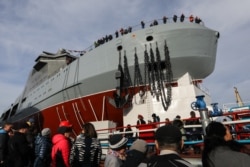On January 3, U.S. Secretary of State Mike Pompeo issued a series of tweets about security issues involving the Arctic Circle. Pompeo wrote that his democratic counterparts from the Arctic Council — the leading intergovernmental forum among the Arctic states — had recognized “the threat” of letting authoritarians “dominate and spoil this geography.”
Pompeo said “if the Arctic region is to thrive, we've got to focus above all on Russian and Chinese threats.”
He continued: “I made clear that it is a communist fiction for China to be a ‘near-Arctic nation’ when you are 900 miles from the Arctic. This pangolin’s nose under the Arctic tent went on for too long – we did what we do by calling out simple reality. #ChinaIsNotNearArctic.”
On January 5, China’s Foreign Ministry spokesperson Hua Chunying was asked about Pompeo’s comments.
Hua replied: "China is a ‘Near-Arctic State,’ a geological, natural and social reality that cannot be denied by anyone, nor changed just because someone or some organization does not like it.”
She added that China is “closely involved in the trans-regional and global issues in the Arctic,” and seeks to work with all concerned parties to “promote sustainable development” there.
“The reality is that the international community is enhancing cooperation in the Arctic, and Mr. Pompeo is so out of touch with this reality by ignoring basic facts, making an issue out of ideology, and sensationalizing security threats in the Arctic,” Hua said.
The claim that “the international community” is merely enhancing Arctic cooperation and Pompeo is sensationalizing security threats in the Arctic is misleading.
While much remains unknown about Beijing’s ambitions, China and Russia’s Arctic expansion includes a strong military component.
China has ramped up activity in the region since gaining observer status on the Arctic Council in 2013. Canada, The Kingdom of Denmark, Finland, Iceland, Norway, the Russian Federation, Sweden and the United States compose the Arctic Council.
While observers do not have voting rights on the council, China announced in November 2018 that its role in the global governance of the Arctic had shifted from that of a "rule follower" to a "rule maker.”
“The security in the region is closely related with China's energy, ecological, military and scientific security,” a Chinese blue paper said.
Earlier that year, Beijing defined itself in a white paper as a “Near-Arctic State.” China’s definition of Near-Arctic State means "one of the continental states that are closest to the Arctic Circle.”
Harbin, the capital of Heilongjiang, China’s northernmost province, is approximately 1,440 miles south of the Arctic Circle. China’s capital, Beijing, is approximately 1,844 miles away.
Berlin, London, and Paris are 971 miles, 1,041 miles, and 1,225 miles away from the Arctic Circle, respectively.
The white paper noted China’s interest in “the commercial use of sea routes and development of resources in the region.”
Russia, too, is looking to exploit the region’s natural resources and trade routes that are becoming increasingly accessible due to melting sea ice. Trillions of dollars in oil, natural gas and other mineral resources are believed to lie beneath the Arctic Circle. The U.S. geological survey estimated the Arctic holds an estimated 13 percent of the world's undiscovered conventional oil resources and 30 percent of its undiscovered conventional natural gas resources.
However, Moscow has failed to secure Western funding to develop such projects due to sanctions stemming from its 2014 annexation of Ukraine’s Crimean peninsula. That has pushed Russia to look eastward for capital.
Chinese state firms have provided funding for Russia’s Yamal liquefied natural gas (LNG) project after sanctions precluded financing from Western banks. State firms from both countries have teamed up to transport LNG from those Arctic plants via a fleet of icebreakers.
Beijing and Moscow have also looked to develop a so-called “Polar Silk Road,” as part of China’s Belt and Road Initiative (BRI) to construct ports, railroads, dams and other major projects across Asia and in Africa.
Russian President Vladimir Putin expressed interest in connecting the Northern Sea Route (NSR), which lies within Arctic waters and Russia’s exclusive economic zone, and the Maritime Silk Road — the “road” portion of the BRI.
European defense analysts note that China would need “a sea-based deterrent” and naval patrols to guard Arctic maritime traffic.
In November 2019, Danish Defense Intelligence Service chief Lars Findsen said the Chinese military was showing an increased interest in being a part of Chinese research activities in the Arctic.
A 2019 annual report to the U.S. Congress noted that Arctic border countries “have raised concerns about China’s expanding capabilities and interest in the region.”
That includes concern expressed by Denmark regarding China’s “interest in Greenland,” including “proposals to establish a research station in Greenland, establish a satellite ground station, renovate airports, and expand mining.”
The report noted that civilian research “could support a strengthened Chinese military presence in the Arctic Ocean, which could include deploying submarines to the region as a deterrent against nuclear attacks.”
China currently operates icebreaker vessels in the region and has research stations in Iceland and Norway.
Western analysts also believe China has the long-term goal of deploying nuclear-powered ballistic missile submarines. The Pentagon has warned that China could deploy submarines to the Arctic as a deterrent against nuclear attack.
Others have cautioned that due to the operational realties of such deployments in the Arctic, “the value of any such [Chinese submarine] presence should not be overblown.”
Rob Huebert, senior research fellow with the Center for Military and Strategic Studies at the University of Calgary, told the Norway-based Barents Observer that talk of China deploying submarines was inevitable given “what the Chinese are doing in the Arctic.”
However, he said there are no open source reports proving the Chinese military has “gained the technological capability and the know-how to operate submarines in the Arctic.”
Meanwhile, Moscow is “ramping up” its presence in the Arctic to ensure its “national security” and “economic interests.”
That is being done through the development and/or upgrade of military facilities, and the expansion/upgrading of its fleet of nuclear-powered icebreakers and submarines.
James Gordon, a now retired United States Navy admiral who last served as commander of United States Naval Forces Europe-Africa and commander of Allied Joint Force Command Naples, expressed fears of a Russian military buildup in the region.
“Who puts missiles on icebreakers? We are seeing Russian navy surface ships and new hybrid Kilo-class submarines operating more often and more widely, particularly in the Black Sea and eastern Mediterranean,” Foggo said in May 2020.
Foggo was referring to the Ivan Papanin Project 23550 Ice-breaking patrol ship, which is designed to carry Kalibr cruise missiles.
In August 2020, the Russian Navy reportedly launched trials of modular systems for the ice-class project 23550 patrol ships that would allow them to upgrade and tailor a variety of different weapons for different missions.











